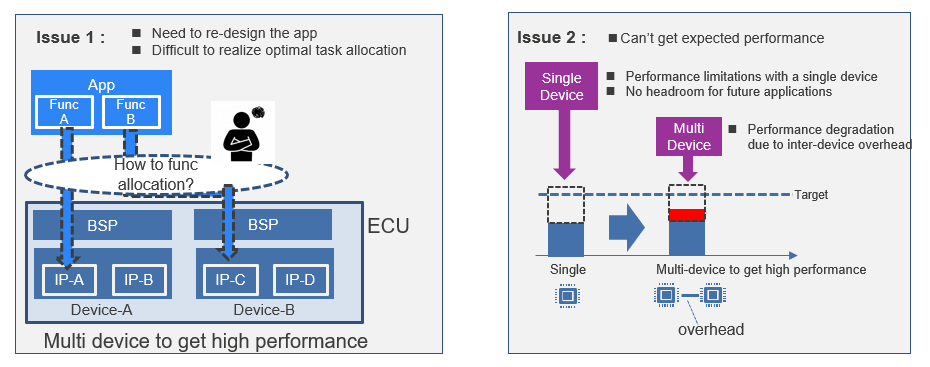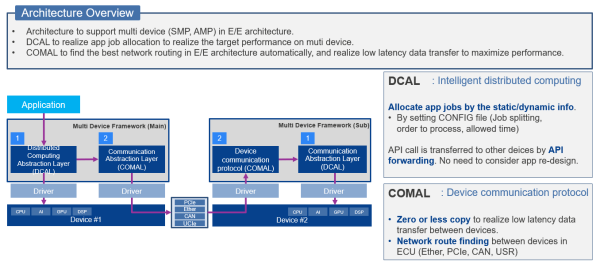Overview
The software-defined vehicle, which defines in-vehicle value through software, requires new applications to be deployed in a variety of vehicle models. For this reason, we are working to develop a solution that allows the developer to develop applications without considering device configuration.
Background
As mentioned above, software defined vehicles, which defines in-vehicle value through software, require new applications to be deployed in a variety of vehicle models. To achieve this, developers need a solution that allows them to easily develop applications without considering device configuration in the ECU and to take maximum performance of the hardware.
However, there are currently issues (Figure 1). When developing high-end vehicles that require high performance, there are cases where multi-device configurations are used. For example, additional devices may be configured to improve the performance of the AI accelerator or the CPU. In such cases, application developers need to consider how to use hardware (execution device and execution hardware (HW) IP) to execute the functions in the application for multiple devices and the implantation of it. (Issue 1) In addition, the expected performance may not be achieved due to data communication overhead between devices. (Issue 2) These issues increase the development time to deploy new applications to the vehicle and its barrier to realize a software defined vehicle.

Concrete Example
Renesas is developing a "Distributed Processing Software for Multi-devices” (Multi-Device Framework) to solve the above issues (Figure 2). This software can maximize the performance of hardware by distributing application functions to CPUs and IPs inside multiple devices (SoCs and microcontrollers) and execute the appropriate allocation. Developers can develop new applications one after another without considering device configuration in the ECU. This allows developers to expand system performance without redeveloping applications for additional devices, even when hardware configurations change. Renesas has a broad portfolio of SoCs for ADAS and Gateways (R-Car series) and automotive MCUs (RH850), that enable application development that combines these devices.
Renesas has these concepts and is working to develop solutions to solve these issues.
The architecture of distributed processing software for multiple devices (Figure 3) consists of a distributed computing abstraction layer (DCAL) that distributes application jobs to the appropriate devices and hardware (HW) IP, and a communication abstraction layer (COMAL) that minimizes data transfer overhead between devices. DCAL efficiently performs distributed processing of HW IPs based on information such as the order of processing and the time allowed. It also includes technology to execute APIs called by applications on other devices. On the other hand, COMAL eliminates data copying by the CPU and reduces communication overhead between devices through high-speed data transfers using HW IP such as PCIe. These core technologies solve the issues for the multi-device faced by application developers. Currently, Renesas is considering and developing prototypes of the core technologies and plan to develop the product for Renesas devices (SoCs for ADAS and gateways, and automotive MCUs) in the future.
Summary
In this article, we have introduced the current issues of distributing and allocating in-vehicle application functions to CPUs and IPs inside multiple devices and Renesas’ activity to solve the issues to realize software-defined vehicles. Renesas is working to provide not only devices but also software and a development environment to create value in vehicles with software.


